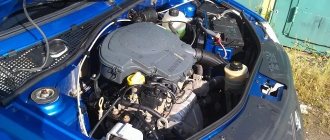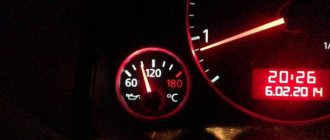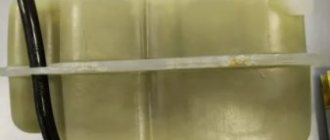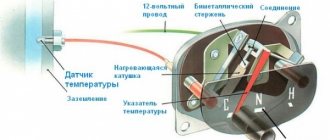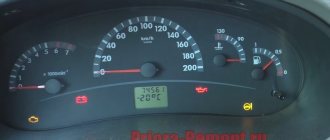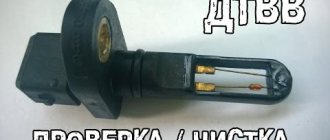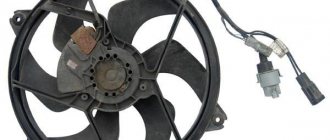Each car engine is equipped with a device for measuring the temperature of the power unit. This component allows the driver to detect overheating in time and eliminate this problem. What is the fan switch on sensor on a VAZ 2109 with a carburetor engine, what is its structure and how to replace it - read on.
Coolant temperature sensor for VAZ 2109 and 21099 cars
First, it is advisable to know where the engine temperature sensor is located. On models 2108, 21099 and VAZ 2109, the coolant temperature sensor is installed between the cylinder head and the thermostat, in the exhaust pipe.
Device and principle of operation
The engine temperature controller itself is a thermistor-resistor device characterized by a negative temperature coefficient. The resistance parameter itself can be measured only when the temperature decreases or increases.
When the power unit heats up as a result of operation, the resistance indicator decreases; if the engine cools down, this parameter increases. For example, at the operating temperature of the engine on a VAZ 2109, the resistance is equal to 180 Ohms, and if it is 40 degrees cold outside, then the resistance will be equal to 100,700 Ohms. On one side of the DTOZH VAZ 2109 injector there are two contacts, and on the other there is a sensitive component, which is located directly in the flow of consumables.
As for the principle of operation, when the driver turns on the ignition, the control unit transmits voltage to the regulator via a resistor. Since the DTOZH itself is a thermistor, the voltage supplied from the control unit changes immediately taking into account the temperature of the consumable. When the parameter decreases, the unit analyzes the temperature and, in accordance with these data, determines the required volume of gasoline for injection. As the power unit warms up, the volume of gasoline that is transferred to the cylinders will decrease.
Two antifreeze temperature sensors for VAZ
In addition to starting, according to the readings of the regulator, the ECU adjusts the operation of the power unit at idle speed. As a result, he independently makes decisions on enriching the combustible mixture at high and medium loads on the internal combustion engine. This indicator can be changed depending on the ignition timing.
There are two temperature sensors on a carburetor car. One turns on the fan, the other is responsible for indicating the temperature on the dashboard.
Possible faults
There are several reasons why the regulator on the VAZ 21099 refuses to work.
So, why DTOZH does not work:
- An electrical contact is located inside the device structure. Over time, this contact may simply break or cracks may form on it. If a break occurs inside the structure, this may cause complete failure. That is, the DTOZH will simply burn out. If there are cracks on the contact, the DTOZH, in principle, can work, but as a result of the lack of normal contact, the regulator will transmit incorrect data about antifreeze.
- Poor device insulation. If the insulation is broken, short circuits may occur in the operation of the device. Accordingly, ultimately, these short circuits can lead to the DTOZH, again, burning out and having to be replaced.
- There was a broken wire near the regulator. As a result of the break, the regulator will not be able to activate the fan designed to cool the power unit. Accordingly, this will lead to the engine overheating and may even boil (the author of the video is a Mechanical Technician).
How can a car owner understand that the DTOZh is out of order and it’s time to replace it?
To do this, it is enough to know about the main signs of problems, which we will discuss below:
- The fan designed to cool the engine can turn on randomly at any time. In particular, the driver should be wary that the fan turns on when the engine is not completely warmed up. Remember that the fan should always function when the internal combustion engine is overheated.
- The driver has difficulty starting a warmed-up internal combustion engine. The cooling system should automatically adjust the temperature, but because the unit is faulty, it cannot receive the correct signal.
- If you carefully monitor the operation of the car, you will notice that gasoline consumption has increased. The increase in consumption is due to the fact that the car is simply overloaded when running on a hot internal combustion engine.
- If the device fails completely, the gauge on the dashboard will show an incorrect temperature signal. A ten-minute drive is enough to warm up the engine. If after 10 minutes the temperature has not risen to the optimal temperature or when starting the internal combustion engine, the dashboard shows overheating, this indicates a malfunction.
Temperature sensor VAZ 2109
If you notice that the coolant temperature gauge is showing an incorrect value, then there is a need to check it. The coolant temperature sensor is designed to monitor engine temperature. Of course, this sensor does not affect the operation of the cooling system of this car in any way. The operation of the cooling system is influenced by the thermostat and the sensor on the radiator, which turns on the radiator cooling fan when the coolant temperature is more than 90 degrees. The coolant temperature sensor is intended only to indicate engine temperature on the nine instrument panel. However, this is also important; you, as a driver, must know the engine temperature.
temperature sensor
The coolant temperature sensor is a thermal resistor, that is, an electrical element that changes its resistance depending on the temperature. The machine's operating manual says that to check the coolant temperature sensor, you need to remove it, then put it in a glass of water of a known temperature and measure its resistance. As always, the developers took the most difficult route: to get the sensor out of the engine, you need to drain the antifreeze to the level of the sensor (and this is not very easy to do, considering that you will have to remove some hose to drain it), go somewhere to heat the water and check it later go back to the car, screw the sensor into place and fill the coolant again.
You can do it much simpler: take three resistors - one 600 Ohm, the second 160 Ohm, the third 100 Ohm. These resistors will simulate a temperature sensor. Open the hood, remove the chip from the temperature sensor and bring it to the battery. We insert a 600 Ohm resistor at one end into the battery ground, and attach a sensor chip to the other end.
Checking the temperature sensor of the VAZ 2109
We go into the salon and turn on the ignition - the temperature gauge needle should show about 50 degrees.
We look at the temperature gauge readings
Then, instead of the 600 Ohm resistor, we insert a 160 Ohm resistor - the temperature indicator arrow should show 90 degrees.
Checking the temperature sensor
We look at the temperature gauge readings
On the third 100 Ohm resistor, the temperature gauge needle should show more than 100 degrees. If, when connecting resistors and changing them, the temperature indicator shows the above values (they may differ slightly), then the wire from the sensor to the indicator and the indicator itself are working. Please note that if you drive a car for more than 10 minutes, that is, with the engine probably warmed up, but the gauge does not show the temperature, then your temperature sensor is really faulty and needs to be replaced, it is inexpensive, about 2-3 $ and is sold in any auto shop. If you connect resistors between ground and the sensor connector, and when the ignition is turned on, the arrow stands dead in place, then the problem is not in the sensor. It is necessary to check the wire from the sensor to the indicator and the temperature indicator itself.
Checking and replacing DTOZH
There are several options for diagnosing the device - the first one:
- The negative probe from the voltmeter must be connected to the engine and turn on the ignition.
- Using a tester, it is necessary to determine what voltage parameter is generated during movement.
- If the DTOZH is working, then the voltage should be at least 12 volts when the battery is fully charged. If the obtained indicators are lower, it is necessary to replace or repair the device.
Temperature and Resistance Correspondence Table
Second diagnostic method:
- You will need to set the multimeter to voltmeter mode - measurements are carried out in the range from 100 Ohms to 10 kOhms. Also prepare a thermometer that can measure temperatures greater than one hundred degrees. The regulator should be removed and placed in a container with antifreeze.
- You need to warm up the coolant. As a result of an increase in temperature indicators, you need to monitor the readings given by the thermometer.
- Using a multimeter, you should measure the resistance of the DTOZH at different temperature conditions. The obtained parameters should be compared with those indicated in the table above.
How to make the replacement yourself:
- First of all, all the coolant must be drained from the radiator. Then disconnect the negative terminal from the battery, simply unscrew the nut with a wrench and disconnect it.
- Next, you need to disconnect the block with wires that connects to the DTOZH.
- Use a wrench to completely unscrew the device. Next, the regulator is removed from its seat; as mentioned above, this is the cylinder head exhaust hose. There is a rubber seal on the device itself; it cannot be lost when dismantling the DTOZH, especially if you have a new sensor without a seal.
- Then install the new regulator in its seat, in the outlet hose. Using a wrench, tighten the adjuster all the way. After installation and tightening, the previously disconnected wiring harness should be connected to the DTOZH. The final step in this process is to pour the antifreeze back into the radiator and reinstall the disconnected negative battery terminal.
Examination
Today, VAZ 2109 car owners use two methods to check the condition of the coolant temperature sensor. Let's say right away that the second one is more reliable, but the first one is easier. Decide for yourself which of the methods presented below to use.
| Verification method | Your actions |
| First way |
|
| Second way |
|
According to the table, check whether the resistance corresponds to that required at a particular temperature of coolant or boiling water.
| Temperature (in degrees Celsius) | Resistance (Ohm) |
| 100 degrees | 177 |
| 80 degrees | 332 |
| 60 degrees | 667 |
| 40 degrees | 1459 |
| 20 degrees | 3520 |
| 0 degrees | 9420 |
| -20 degrees | 28680 |
| -40 degrees | 100700 |
If there are deviations from the norm, we conclude that the sensor no longer performs its functions properly and therefore requires mandatory replacement.
Replacement
Video “Visual instructions for replacing the device”
You can learn how to replace the sensor yourself at home from the video below (the author of the video is Thoughts and advice from Mustafa Murtazaev).
The cooling system is responsible for the optimal temperature regime of the power plant, at which the power output is maximum. This system includes a radiator cooling jacket and pipes through which fluid circulates. Circulation is provided by a pump driven by the crankshaft.
Various types of coolant temperature sensors
The system also includes a thermostat, which ensures quick warm-up of the engine by shutting off the pipeline going to the radiator, while the liquid circulates only inside the cooling jacket. When a certain temperature is reached, the thermostat opens the pipe, after which the liquid circulates in a large circle, including the radiator.
The radiator cools the heated liquid. To cool the liquid faster, a fan is installed on the radiator, which creates additional air flow. But this fan does not always work; it turns on only when the liquid temperature exceeds a certain value.
Coolant temperature sensor
To monitor the coolant temperature, this system includes a coolant temperature sensor (CTS). The readings of this sensor are displayed on the dashboard, which provides the driver with information about the temperature conditions of the engine.
But this is not the main task of this sensor. The coolant temperature sensor transmits temperature data to the electronic control unit, after which this unit adjusts the fuel supply depending on the temperature. When the engine is cold, based on the readings of this sensor, the control unit sets an enriched mixture; after warming up, the fuel mixture becomes normal. Based on the readings of this element, the electronic unit regulates the ignition timing.
So the normal operation of the engine and fuel consumption largely depend on this sensor. It also drives the radiator fan. On some cars, a separate sensor is used to turn on the fan. It can be located either near the DTOZH or in the radiator.
Coolant level sensor repair
If the sensor contacts are intact, but the sensor itself does not function as it should, then it can be repaired.
- Remove the sensor from the car.
- Remove the amendments.
- Using sealant, glue it well to the body.
- Then solder the joint (isolate it from antifreeze).
This way you can repair the plastic float. The porous float must be replaced, however, you can find a similar part and install it in its place.
Signs of sensor malfunction
The temperature sensor is considered to be very reliable due to its comparative simplicity of design. However, there may be problems with it too. Usually they come down to a violation of the calibration, which leads to a violation of the resistance and, as a result, incorrect operation of the electronic unit, since it performs part of its functions based on the engine temperature.
One of the most obvious signs of DTOZ failure is the failure of the fan to turn on when the temperature exceeds the set value. But this indicator will not be reliable if there are two sensors - the main one, for transmitting the temperature value to the electronic unit, and the additional one, responsible for turning on the fan. In this case, failure to turn on the fan will indicate damage, oxidation of the wiring, or failure of the sensor responsible for its operation.
On modern cars, a malfunction indicating incorrect operation of the coolant temperature sensor is displayed on the display of the on-board computer. However, a fault message does not always indicate sensor failure. Often problems in its operation are associated with broken wiring or oxidation of contacts.
Incorrect functioning of the coolant temperature sensor or a break in its wiring leads to excessive fuel consumption, high idle speed, and detonation. It is possible that the power unit will have difficulty starting after warming up. The biggest trouble that can occur due to the inoperability of this sensor is overheating of the power plant, which can cause the cylinder head to move.
Malfunctions
There are several main malfunctions that lead to failure of the coolant temperature sensor. Namely:
- There is an electrical contact inside the sensor that may break or become cracked. If the contact is broken, this leads to complete combustion of the regulator. If there are cracks, the sensor can still function, but the lack of proper contact does not allow accurate information about the coolant to be transmitted;
- Sensor insulation is broken. If the wiring insulation is poor, short circuits occur. They, in turn, cause the device to burn out;
- Wires break near the sensor. Because of this, the regulator cannot turn on the fan, which leads to overheating of the car.
In the summer, a failure in the operation of the diesel engine is rarely noticed, but in winter it becomes much more difficult to start the engine.
Signs of breakdown
How can you determine that the coolant temperature sensor has stopped working normally or has completely burned out?
- The cooling fan turns on randomly even at normal engine temperature. But in fact, the fan should only turn on when the power unit overheats.
- It's difficult to start the engine when it's hot. The cooling system is responsible for regulating the temperature, but a faulty sensor does not allow obtaining objective data and a signal to start a particular operating mode.
- Fuel consumption increases noticeably. This is caused by overloading the engine, which has to drive at elevated temperatures. Because of this, fuel consumption is increasing.
Read more: Low beam golf 6 Before drawing final conclusions regarding the breakdown or malfunction of the DTOZH on the VAZ 21099, be sure to carry out verification activities.
Sensor check
Diagnosing the performance of the DTOZH is not difficult. But before you do it, it is advisable to check the integrity of the wiring going to it. You can also check the voltage coming from the control unit. To do this, you need to disconnect the chip with wires from the sensor and connect it to a voltmeter. After this, start the engine and measure the voltage supplied to the sensor; it should correspond to 5 V.
To remove, diagnose and replace the temperature sensor you will not need much:
- Key to 19;
- Multimeter;
- Container for draining coolant;
- Electric kettle;
- Thermometer;
Before removing the element, you need to partially drain the liquid from the system. It is not necessary to drain it all, since it is located at the top of the engine; it is enough to drain it to a level below the DTOZH position.
Then the chip with wiring is disconnected from the sensor. Using the 19 key, it turns out of its seat.
Video: Checking the coolant temperature sensor
Something else useful for you:
Check the sensor using an electric kettle with a thermometer and a multimeter set to resistance measurement mode. There are two ways to carry out diagnostics.
- In the first method, the working part of the DTOZH is immersed in an electric kettle with cold water, and a thermometer is also placed there. You can only use an electronic thermometer that can measure high temperatures. A multimeter is connected to the sensor itself and the electric kettle is connected to the network. As the water temperature rises, the sensor resistance will drop. So, at a water temperature of +15 C, the resistance should be 4450 Ohms. At +40 C, the multimeter reading should be 1459 Ohms. The water needs to be heated to a temperature of 100 C. At this value, the resistance should be minimal - 177 Ohms. If the values differ, it means that the sensor is providing incorrect information.
- The second method is suitable if you do not have a thermometer. To measure the resistance, the DTOZH is immersed in water after it has boiled. In this case, the water temperature will approach 100 C. This is quite enough for taking measurements. After lowering the working part of the temperature sensor into boiling water, the resistance should be slightly more than 177 Ohms. If the difference is large, the sensor is faulty.

